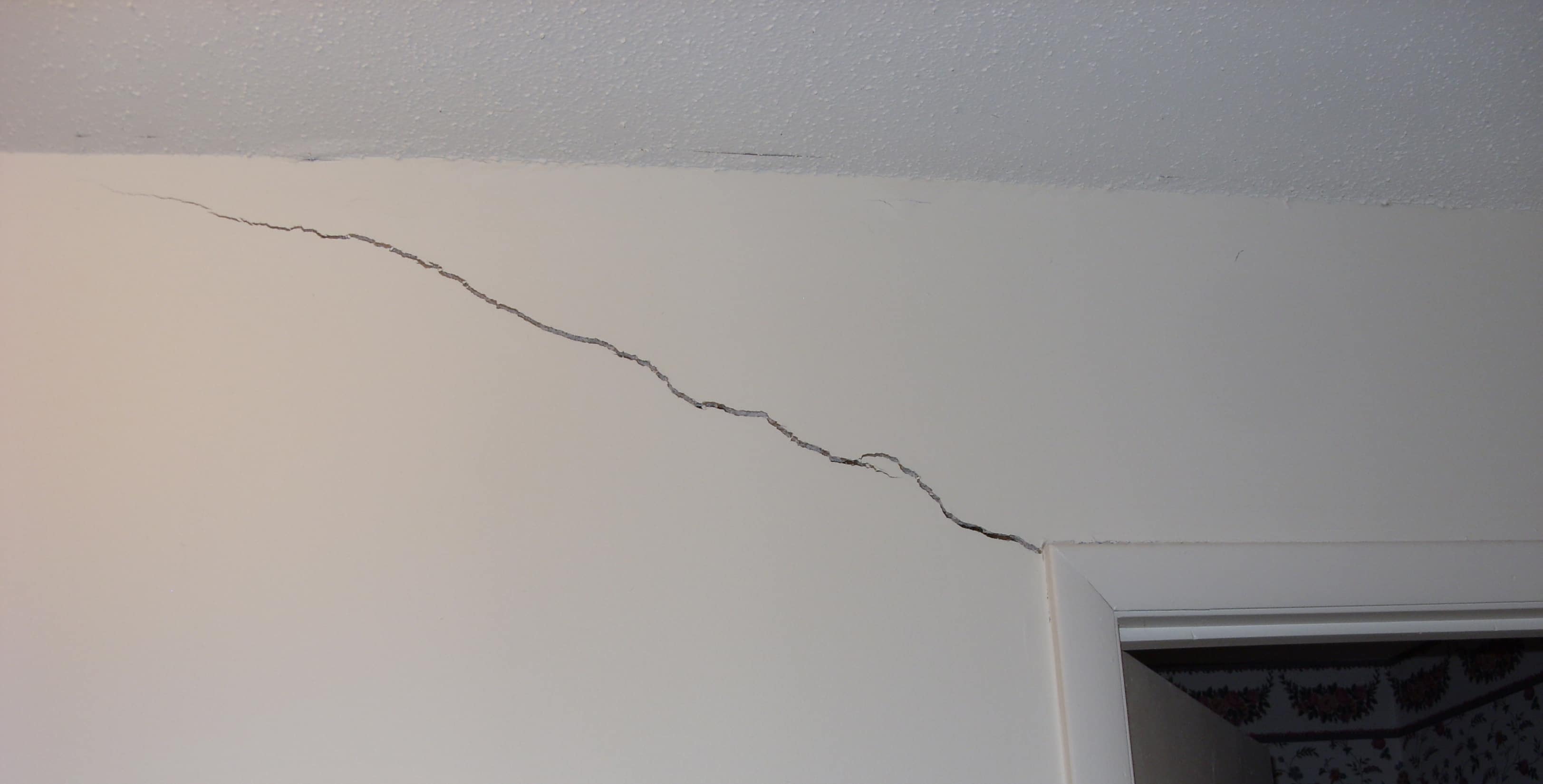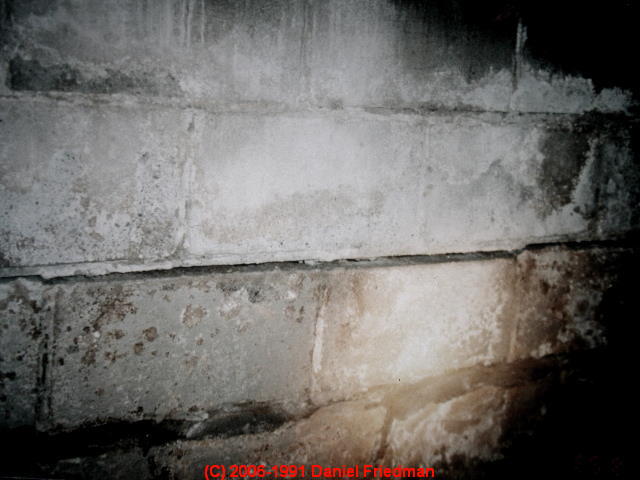Inspected a slab house today built in '89 and it had horizontal separation hairline cracks between pieces of sheetrock approximately 3' from floor level all the way around the first floor family room (exterior walls.) Largest gap was approximately 1/64'. House had several other thin cracks above windows and doors and tape separation at wall to ceiling junctions in several areas. Nothing too big but just a lot of them. I've never seen horizontal cracking along three exterior walls.
No signs of bowing and no significant foundation cracks. Any idea what is going on? Similar Threads: • • • • •.
How high was the room? If 11' (approx) the horizontal crack, 3' off the floor is likely poor taping and mudding at a joint. Overall it sounds like a shoddy drywall and taping job, anyway. Cracks around/above windows and doors may because the drywall was pieced, rather than installing larger/full sheets and cutting out the opening once hung. The installer may also have missed studs with screws/nails or even failed to install each joint over a stud/nailing surface. Running a stud-finder over the cracks might have provided some enlightenment. There could also be issues with the framing. Autoplay Media Studio Samples.


Hard to tell without being there. The limited locations (exterior walls), bad continuous horizontal seam at 3' up on all walls, and occasional lifting at wall-ceiling junctions, seams and areas near windows, are suggestive of water infiltration problems on outside walls, collections of water and moisture issues at floor plates, and crap remediation work for problems due to same. Its pretty SOP to R&R to 3' when the wall plates have been saturated and there has been wet insulation and/or mold/mildew issues on the drywall. Avoiding the FB & bracing which might be horizontal, staggered, or herringbone. The crap workers don't pull together using blocking transition installed behind the exsisting and dropping down in the cavity to transition and support the seam between the pre-existing sheet and the replacement.
Bad tape jobs and repairs elsewhere are also common. Whole job screwy if the area wasn't left open for sufficient time and dries out completely. If home unocupied and unconditioned - repair work won't dry/cure properly either. Marco Masini Disco Grafia De Los Bukis. I'd be looking for infiltration/repairs on the exterior, gutter/roof leaks, window leaks, finishing system or sheathing flashing, drainage, defects, checking fire reports, and clue reports, and checking the outlets in the repaired zone, as well as if the area is Wall-to-wall carpet, checking under the carpet and pad at the exterior walls & outside corners. Another possiblity at 3' up is removal/replacement of a chair-rail moulding & other moldings elsewhere (carpentry trim) and/or panelized bead-board (nailed and/or glued directly upon prior gyp board?) or other decorative wall finish from the area (might have been poorly DIY installed and unattractive and was removed and refinished less-than-idealy). All Rights Reserved. Hann Tech Marketing Link / InspectionNews.com / InspectionNews.net - No part of InspectionNews.net may be reproduced in any way, or by any means, without the prior written permission of InspectionNews.net.
Use of any index or listing Software for the purpose of constructing a mailing list, creating promotional materials or producing a printed or electronic catalog of any kind is expressly forbidden without the prior written permission of InspectionNews.net - All text, graphics and design on InspectionNews.net is copyright by Hann Tech Marketing Links.
The least expensive method of repairing the crack involves re-taping the horizontal seam where the wall meets the ceiling. Before applying a new drywall.
Ceiling Cracks and What They Tell You About Your Foundation When you spend so much time in your home, you often become conditioned to the way things are. In other words, you may not notice small details and issues that others would. This is often the case when it comes to ceiling cracks. Homeowners can go months or years without noticing the severity of a crack.
And while it’s possible that you just need a little plaster and paint to fix the issue, it’s also possible that cracks in your ceiling signify an issue with your home’s foundation. Significance of Ceiling Cracks Quite frankly, knowing the difference between the different types of ceiling cracks can save your home. If nothing else, it can prevent unnecessary stress and anxiety. Sadly, most homeowners are completely oblivious to what their home’s cracks are telling them. This is the most dangerous situation you can be in. As a little primer on the subject, it’s important to know that all homes and manmade structures are.
This movement is caused by a number of factors, including weather fluctuations, settlement in the groundwork, moisture, and more. While there may be other causes, ceiling cracks are virtually always related to one of two things. They are either the result of natural aging or structural damage.
Obviously, the former is preferred – as it points to a simple repair need – but don’t be dismayed by the possibility of the second. Structural damage comes in many different forms.
Some are less serious than others. Causes of Ceiling Cracks Now that you know the two main categories of ceiling cracks – aging or structural damage – let’s quickly investigate some of the specific causes and how they impact your ceilings. Moisture One of the most common causes is heavy moisture damage from above the ceiling. Depending on which floor of your home you’re talking about, this could mean moisture has seeped into the floor above the ceiling. If it’s the upper level of your home, this may signify damage to the roof. “Common sources of moisture that create ceiling damage might be plumbing leaks from the floor above, originating from sinks, bathtubs or a plumbing vent,”, home improvement writer.
“If you have a significant storm with high winds and excessive precipitation and you suddenly notice evidence of moisture in the ceiling, it’s likely that your home suffered roof damage.” If there are major fluctuations in temperature in your area, this combination of moisture and drastic changes can lead to cracks. This is simple science. As the temperature becomes warmer, the building materials in your home – because they are exposed to excess moisture – will expand.
Then, as the temperature drops, they will contract. The quick changes between hot and cold can place stress on the ceiling materials and joints, and lead to cracking. Too Much Weight Your cracked ceiling either has another floor above it or some attic space.
Because of this, it’s possible that the space above the ceiling is bearing too much weight. For example, bathrooms on upper levels need very specific ceiling supports to carry the heavy weight of fixtures.
If shortcuts were taken during construction, this could ultimately lead to sagging or cracking. On a related note, it’s possible that your ceiling drywall is simply not sufficient for the other building materials used in your home. It’s also a possibility that seams, butt joints, and adjacent drywall sheets aren’t positioned in the right manner. Any number of these factors can accelerate the aging and deterioration of your ceiling. Inferior Foundation Finally, we come to the scary word: foundation! Don’t worry, though, it doesn’t have to be that intimidating. By understanding that ceiling cracks can be a symptom of foundation problems, you’ll ultimately be more aware of them in the future.
This will hopefully let you catch problems in advance so you can take care of them before they become bigger problems. An inferior foundation can cause an array of structural issues, including damage to the ceiling. While it may be hard to fathom how two aspects of the home which are so far away from each other can be so interconnected, remember that the integrity of the foundation affects every component of your home. Even the slightest movement or settling in the foundation can alter load bearing beams and cause small or large cracks. Types of Ceiling Cracks Not all cracks are created equal.
Let’s take a look at some of the most common and what they likely tell you: 1. Spider Web Cracks As the name suggests, spider web cracks are those cracks that have a center point and then spread out in different directions. These cracks are a normal part of home settling and can occur in ceilings, walls, and even floors. When it comes to spider web cracks, size is important. If the cracks are small, there isn’t much to worry about.
However, if they are more than 1/16 inch wide, there could be a larger structural problem at stake. Matching Vertical Cracks “Cracks that cause concern are those which run across the length of a ceiling and then continue down a wall along the same line,” of SF Gate Home Guides. This is a sign of structural damage, usually related to a weak wall stud or perhaps something that was jarred loose in an earthquake or the settling of the home over time.” Again, size comes into play here.
Cracks Along the Edges Cracks along the edges of walls are typically the result of normal settling. You don’t have to be super worried about these, but it is a good idea to mark where they start and finish so that you can monitor any growth.
It’s the cracks that run across the entire length of the ceiling that can be problematic. Contact Edens Structural Today When it comes to cracks in your ceiling, location and type are both very important. While you may be able to eyeball the cracks and tell exactly what’s happening, you shouldn’t rely on your own intuition when your home’s safety and integrity could be at stake. For a professional evaluation and consultation of your home’s evaluation, please!
We would be happy to help you better understand your home’s foundation needs.